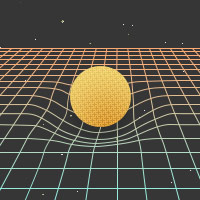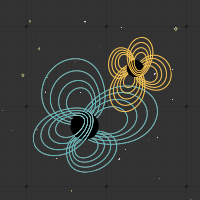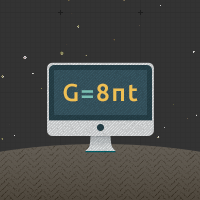The Warped Point of View
Where “now” depends on how heavy you are
Go, wond'rous creature!
Mount where Science guides,
Go, measure earth, weigh air,
and state the tides;
Instruct the planets in
what orbs to run,
Correct old Time,
and regulate the Sun.Alexander Pope's
An Essay on Man
Einstein saw a beautiful idea in his notion of curved space and time. He saw that the falling astronaut wasn't being pulled or pushed by anything, but just moving along a straight line (a geodesic) through curved spacetime. He realized that gravity could be reinterpreted, not as a force pulling on objects, but as a curvature of spacetime. Objects falling in a gravitational field — like around the Earth — aren't being pulled, but are simply moving along geodesics in the warped spacetime surrounding any heavy object. The Moon's orbit doesn't circle the Earth because of a pull, but because the straightest line through spacetime brings it back to the same point in space.
This bending of spacetime is particularly noticeable on Earth; throw a ball up in the air, and it follows its geodesic as it rises and falls. You can't miss the bending. To Einstein, the ball falls because spacetime is curving — not because there is a force pulling it back to Earth. While it is in the air, there is no force on the ball (except air resistance). We see it accelerate because there is a force acting on us: the force of the ground pushing up. Interestingly, Einstein's version of Newton's First Law of Motion says that we are not following a straight line (a geodesic) while standing still on solid ground.
Now, the space we are used to seems pretty flat — spheres act just as we learned they should in high-school geometry, for instance. So, we might think that spacetime must not be very warped. It turns out that it's very important to keep tabs on the warping of time, too. The motion of objects is very sensitive to this kind of warping, though most of us find it very difficult to understand this intuitively.
The essential idea here is that slices of spacetime are curved, and how they are curved changes the flow of time. Recall that a slice of spacetime is a set of points that an observer picks out, and says that everything on that slice happens at the same time. This changing leads to another interesting effect. We saw earlier that astronauts moving relative to each other take different slices, and thus see things happen at different times.
A similar thing happens with slices warped by gravity. An astronomer on the Earth will move through the slices more slowly than an astronaut on the Moon, where the gravity is less intense. Moving through the slices more slowly means that the astronomer will get old more slowly than the astronaut. The effect is tiny and wouldn't ordinarily be noticed by humans, though it has been measured in extremely sensitive experiments.
All these descriptions of the effects of warped spacetime are useless, though, without any idea of how or why spacetime warps. To actually achieve his goal of predicting how objects move in their geodesics, or how time flows in different places, Einstein had to explain how massive objects curve spacetime. He devised an elegant — though extremely complicated — set of equations. We call these Einstein's equations, appropriately. They can be written in a beautifully simple form:
$$G=8πT.$$
The \(G\) on the left side represents all the curvature of spacetime at a point, while the \(T\) on the right represents the mass at a point and its properties, and the same equation holds at every point in space and time. This is the elegant part.
The complicated part comes when we realize that this formula is almost completely useless for doing actual calculations. To use it, we have to expand it into at least ten different equations, each with dozens of terms. It is possible to solve the equations with pencil and paper in very special situations — when most of the dozens of terms happen to be zero — or in situations with low speeds, small masses, and large distances — when most of the dozens of terms happen to be very small and practically zero.
Most things in the Solar System, including on Earth, qualify for the low speed, small mass, and large distance situation. In this case, Einstein's theory gives exactly the same results as Newton's old theory of gravity. That's good news because Newton's theory worked very well in describing objects falling near the Earth, the planets orbiting the Sun, comets, and so on. Einstein's fancy warped spacetime theory would be all well and good, but needlessly complicated if it just reproduced what Newton had written down over three hundred years earlier. In cases with high speeds, small distances, or large masses, however, Einstein's theory is different from Newton's. This allows us to test the two theories, and decide which one is correct.
There was one exception to all the success of Newton's theory. For years before Einstein wrote down his equations, astronomers had known that the details of Mercury's orbit didn't perfectly match Newton's predictions. The difference was small, but clearly present. Mercury is the planet closest to the Sun. This combines a large mass (the Sun's) with small distances, which is one situation where Einstein's equations are not the same as Newton's. The very first thing Einstein did after discovering his equations was to solve them for the orbit of Mercury. He picked out the detail that Newton's theory couldn't account for, and saw that his own theory predicted it correctly. This was the first trial, and first success of Einstein's theory. He had shown that Newton was very nearly right much of the time, but wrong in the most extreme cases.
Einstein's theory doesn't just correct details in Newton's theory, but introduces completely new phenomena, like time warping and gravitational waves. Since his introduction of the General Theory of Relativity, there have been many experiments testing his ideas and his equations. Every test so far has proven Einstein right and verified his new predictions, but the tests aren't over yet.
We know that Einstein's theory can't account for everything; we know that at some point there will be a deeper theory that will correct General Relativity, just as Einstein corrected Newton. Physicists are now embarking on a journey of discovery, and beginning to peer into the Universe in ways unlike ever before. They expect to see Einstein's theory fail so that they can gain a better understanding of the true laws of the Universe. They will make this journey with help from gravitational waves and numerical relativity.
Find out more about Gravitational WavesRead about Numerical Relativity






